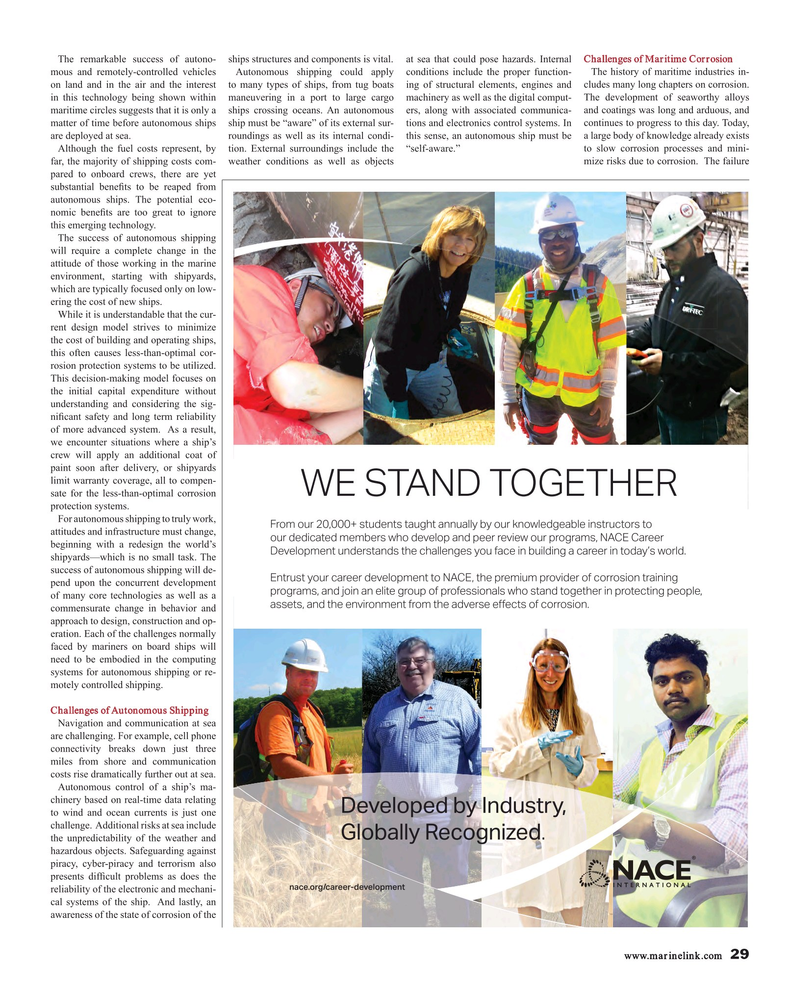
Page 29: of Maritime Reporter Magazine (March 2018)
Annual World Yearbook
Read this page in Pdf, Flash or Html5 edition of March 2018 Maritime Reporter Magazine
The remarkable success of autono- ships structures and components is vital. at sea that could pose hazards. Internal Challenges of Maritime Corrosion mous and remotely-controlled vehicles Autonomous shipping could apply conditions include the proper function- The history of maritime industries in- on land and in the air and the interest to many types of ships, from tug boats ing of structural elements, engines and cludes many long chapters on corrosion. in this technology being shown within maneuvering in a port to large cargo machinery as well as the digital comput- The development of seaworthy alloys maritime circles suggests that it is only a ships crossing oceans. An autonomous ers, along with associated communica- and coatings was long and arduous, and matter of time before autonomous ships ship must be “aware” of its external sur- tions and electronics control systems. In continues to progress to this day. Today, are deployed at sea. roundings as well as its internal condi- this sense, an autonomous ship must be a large body of knowledge already exists
Although the fuel costs represent, by tion. External surroundings include the “self-aware.” to slow corrosion processes and mini- far, the majority of shipping costs com- weather conditions as well as objects mize risks due to corrosion. The failure pared to onboard crews, there are yet substantial bene? ts to be reaped from autonomous ships. The potential eco- nomic bene? ts are too great to ignore this emerging technology.
The success of autonomous shipping will require a complete change in the attitude of those working in the marine environment, starting with shipyards, which are typically focused only on low- ering the cost of new ships.
While it is understandable that the cur- rent design model strives to minimize the cost of building and operating ships, this often causes less-than-optimal cor- rosion protection systems to be utilized.
This decision-making model focuses on the initial capital expenditure without understanding and considering the sig- ni? cant safety and long term reliability of more advanced system. As a result, we encounter situations where a ship’s crew will apply an additional coat of paint soon after delivery, or shipyards limit warranty coverage, all to compen-
WE STAND TOGETHER sate for the less-than-optimal corrosion protection systems.
For autonomous shipping to truly work,
From our 20,000+ students taught annually by our knowledgeable instructors to attitudes and infrastructure must change, our dedicated members who develop and peer review our programs, NACE Career beginning with a redesign the world’s
Development understands the challenges you face in building a career in today’s world. shipyards—which is no small task. The success of autonomous shipping will de-
Entrust your career development to NACE, the premium provider of corrosion training pend upon the concurrent development programs, and join an elite group of professionals who stand together in protecting people, of many core technologies as well as a
DVVHWVDQGWKHHQYLURQPHQWIURPWKHDGYHUVHH?HFWVRIFRUURVLRQ commensurate change in behavior and approach to design, construction and op- eration. Each of the challenges normally faced by mariners on board ships will need to be embodied in the computing systems for autonomous shipping or re- motely controlled shipping.
Challenges of Autonomous Shipping
Navigation and communication at sea are challenging. For example, cell phone connectivity breaks down just three miles from shore and communication costs rise dramatically further out at sea.
Autonomous control of a ship’s ma- chinery based on real-time data relating
Developed by Industry, to wind and ocean currents is just one challenge. Additional risks at sea include
Globally Recognized.
the unpredictability of the weather and hazardous objects. Safeguarding against piracy, cyber-piracy and terrorism also presents dif? cult problems as does the nace.org/career-development reliability of the electronic and mechani- cal systems of the ship. And lastly, an awareness of the state of corrosion of the www.marinelink.com 29
MR #3 (26-33).indd 29 MR #3 (26-33).indd 29 3/5/2018 12:39:53 PM3/5/2018 12:39:53 PM

 28
28

 30
30
